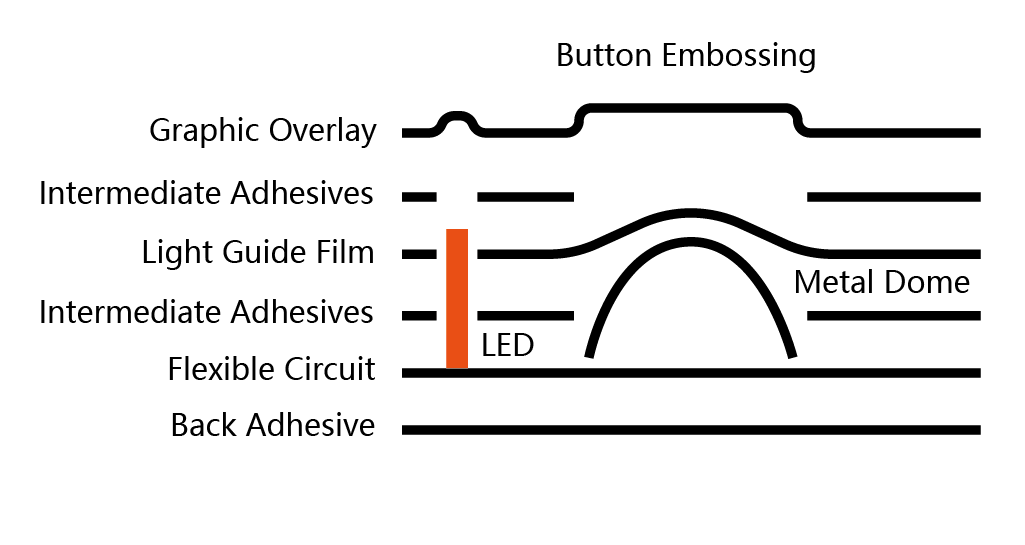Design tips for maximizing membrane switch efficiency
Wiki Article
Understanding the Significance of Membrane Change in Modern Electronics
Membrane buttons are indispensable parts in contemporary electronic devices. They supply a mix of performance and style that boosts user interaction. Their long lasting and lightweight nature makes them suitable for different applications. As industries evolve, the need for modification and progressed features expands. Recognizing exactly how membrane switches over add to development discloses their relevance in shaping the future of electronics. What lies ahead for this technology?The Essentials of Membrane Switch Over Innovation
Typically overlooked, membrane layer switch innovation plays an important duty in the modern electronic devices landscape. These tools, composed of several layers, function as interface for various electronic items, ranging from home devices to medical devices. A typical membrane button includes a graphic overlay, a spacer layer, and a circuit layer, which are thoroughly assembled to produce a useful interface.When stress is related to the overlay, the circuit layer is completed, enabling signals to be transmitted to the tool. This innovation is recognized for its adaptability, making it possible for customization in form, layout, and functionality to satisfy details customer demands. Additionally, membrane switches are thin and lightweight, making them suitable for applications where space is a premium. Their toughness and resistance to ecological factors even more enhance their charm, ensuring they can endure extreme problems while preserving performance. Generally, membrane layer switch innovation is important to producing effective and easy to use digital tools
Key Benefits of Membrane Layer Changes
Membrane layer switches over deal several essential advantages that make them a recommended option in different electronic applications. Their style permits a portable type factor, making it possible for makers to create streamlined and lightweight devices. In addition, membrane buttons are resistant to dust, dampness, and chemicals, which improves their resilience and long life sought after settings. The tactile responses offered by these buttons can improve user experience, making them instinctive and easy to operate.Furthermore, membrane layer switches can be personalized with varied graphics and colors, enabling distinct branding chances. The production process is typically cost-effective, specifically for high-volume production, as it minimizes setting up time and simplifies style. Ultimately, membrane changes call for minimal maintenance, adding to reduced overall operational prices. These benefits emphasize their growing popularity in contemporary electronic devices, where integrity and user-friendly interfaces are crucial.
Applications Across Numerous Industries
The adaptability of membrane changes enables their prevalent adoption throughout different sectors. In the medical area, they are frequently used in analysis equipment and individual monitoring systems, supplying a resilient user interface resistant to impurities. The automobile sector utilizes membrane switches for dashboard controls, improving user experience with smooth styles that withstand extreme problems. In consumer electronic devices, they work as control board for devices such as microwaves and coffee machine, providing an easy to use user interface that is simple to tidy. The aerospace field utilizes membrane layer buttons in cockpit controls, where dependability and room efficiency are vital. In addition, the industrial industry leverages these buttons in equipment and control systems to guarantee robust procedure in requiring environments. This broad variety of applications emphasizes the flexibility of membrane switches, making them important parts our website in enhancing performance and individual communication throughout varied technical landscapes.Customization and Design Flexibility

Future Trends in Membrane Change Growth
Emerging fads in membrane layer button growth show an expanding emphasis on enhanced functionality and integration with wise modern technologies. As consumer demand for much more advanced electronic gadgets boosts, suppliers are concentrating on creating membrane changes that not just serve basic operational duties yet additionally integrate functions like touch sensitivity, you can check here backlighting, and haptic feedback.Furthermore, developments in products are anticipated to improve sturdiness and environmental resistance, making membrane switches over ideal for diverse applications in industries such as medical care, vehicle, and customer electronic devices. The integration of capacitive touch technology is most likely to end up being more common, permitting sleeker layouts and enhanced customer interfaces. membrane switch.Additionally, the increase of the Net of Points (IoT) is triggering the development of membrane layer switches that can connect wirelessly with other devices, improving interconnectivity. Overall, the future of membrane layer switch innovation shows up promising, driven by technology and the quest of straightforward servicesFrequently Asked Concerns
How Do Membrane Changes Compare to Typical Mechanical Buttons?
Membrane layer buttons, being much more space-efficient and offering a smooth layout, comparison with conventional mechanical buttons that offer tactile comments. The previous typically include customizable graphics, while the latter commonly guarantee longevity and reliability in different applications.What Products Are Generally Used in Membrane Switch Production?
Membrane layer buttons are typically produced utilizing products such as polyester, polycarbonate, and published conductive inks. These materials offer responsiveness, versatility, and sturdiness, making them appropriate for different applications in electronic gadgets and interface.Can Membrane Switches Be Repaired or Recycled?
Membrane layer buttons can commonly be fixed, particularly if minor issues emerge, such as sticky failure or surface area damages. Full reuse is normally limited due to put on and prospective degradation of products over time.
How Do Ecological Aspects Affect Membrane Layer Switch Efficiency?
Environmental variables, such as direct exposure, humidity, and temperature to chemicals, significantly influence membrane button performance. Extreme conditions can bring about degradation, impacting responsiveness and longevity, eventually endangering the functionality of the gadget in numerous applications.What Is the Common Life-span of a Membrane Change?
The normal lifespan of a membrane switch usually ranges from 1 to 5 million actuations, depending upon aspects such as use frequency, environmental problems, and the products made use of in manufacturing, affecting longevity and performance longevity. A common membrane layer switch is composed of a visuals overlay, a spacer layer, and a circuit layer, which are meticulously put together to produce a practical interface - membrane switch.When stress is used to the overlay, the circuit layer is finished, allowing signals to be transmitted to the device. The tactile comments supplied by these buttons can boost user experience, making them simple and user-friendly to operate.Furthermore, membrane layer buttons can be personalized with varied graphics and colors, enabling for special branding chances. As customer demand for a lot more advanced electronic gadgets boosts, producers are focusing on creating membrane switches over that not just offer fundamental operational functions yet additionally include attributes like touch level of sensitivity, backlighting, and haptic feedback.Furthermore, innovations in products are expected to improve resilience and environmental resistance, making membrane switches over appropriate for diverse applications in industries such as healthcare, auto, and customer electronics. The integration of capacitive touch technology is most likely to end up being much more prevalent, permitting for sleeker layouts and enhanced user interfaces.Additionally, the surge of the Web of Things (IoT) is motivating the growth of membrane switches over that can interact wirelessly with other devices, boosting interconnectivity. Membrane layer switches, being extra space-efficient and using a sleek layout, contrast with traditional mechanical buttons that offer responsive commentsReport this wiki page